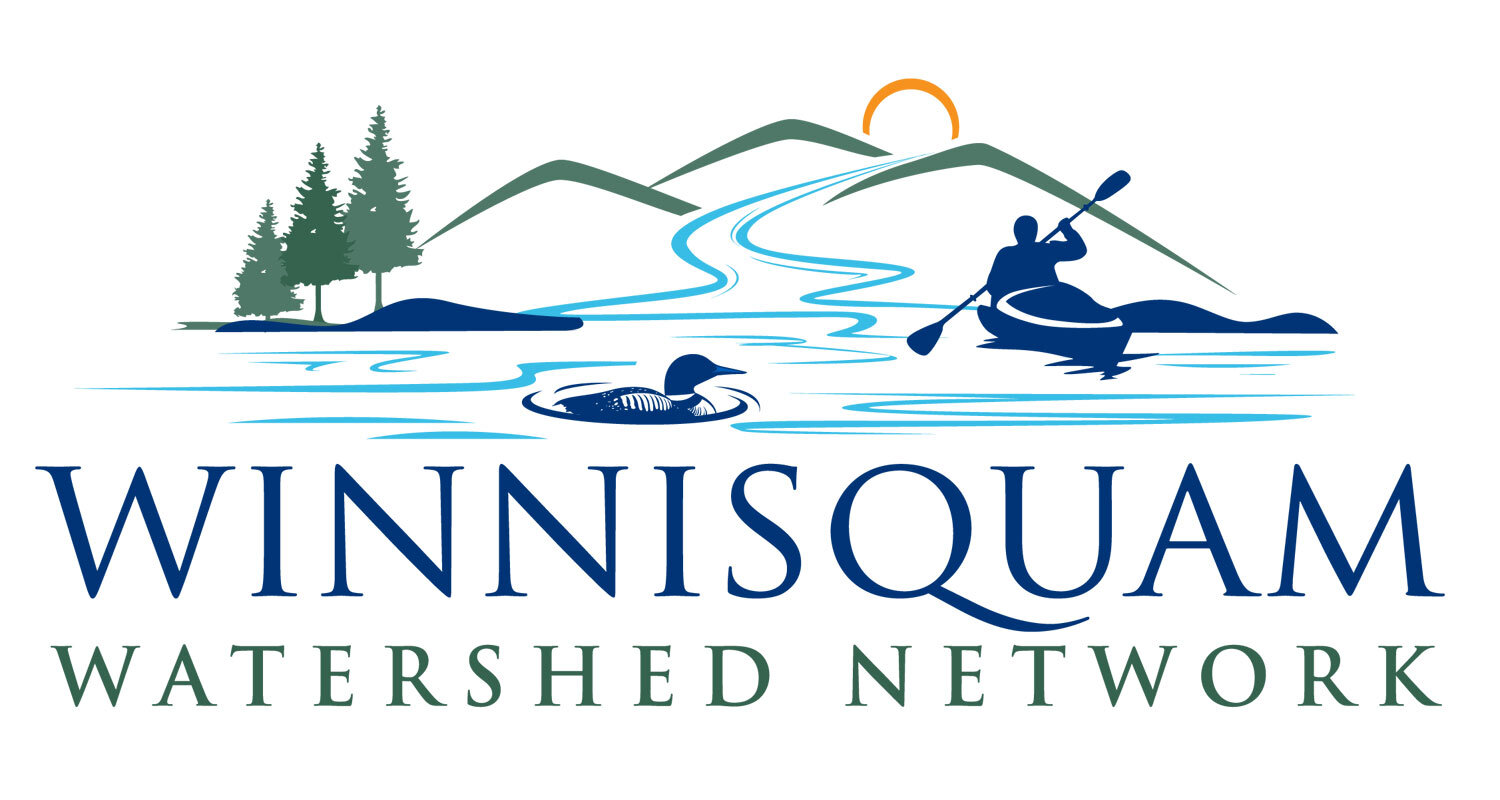
Milfoil Control Program
Variable milfoil (Myriophyllum heterophyllum) is an invasive plant that became established in Lake Winnisquam sometime around 1995. Milfoil growth has been primarily confined to the northern end of the lake near the loon sanctuary, Winnisquam Marine, East Coast Flightcraft (Jay’s) Marina, Sunray Shores (a dredged channel to developed land in Belmont), Ephraim’s Cove and Mallards Landing. NHDES surveys the lake each year to document where the areas of infestation are, and to determine if there are any new areas of growth. See the 2023 map for Diver Assisted Suction Harvesting (DASH), and the most recent Long Term Variable Milfoil Management Plan 2020 documented by NHDES.
Prior to the creation of the Winnisquam Watershed Network in 2017, milfoil management in Lake Winnisquam was conducted on a localized basis and some areas of infestation had not been treated in more than 10 years. The WWN’s approach is to conduct milfoil management throughout the lake each year with the ultimate goal of reducing or eliminating the milfoil growth in infested areas and preventing further spread. Beginning in 2021, after 3 years of management, and continuing through 2023 we were able to manage each year’s milfoil growth with just diver-assisted harvesting and no herbicide treatment.
Funding for the program comes from State grants, local matches from each of the five municipalities on the lake, and contributions from neighborhood associations and members. For more details on variable milfoil, see the Environmental Fact Sheet from the NHDES.
2024 Campaign
In early August TSE Dive Services conducted 3 days of hand harvesting milfoil in the north end of the lake. After 3 years without the need to use herbicides, regrowth in several areas of the lake required herbicide treatment. In August SOLitude Lake Management applied Flumioxazin to treat water violet in Jays Marina and Procellacor to treat variable milfoil in Jay's Marina, Ephraim's Cove, Sunray Shores, Winnisquam Marine and the no-wake zone at the north end of the lake. They have since completed their residue sampling and post-treatment surveys. According to the end of year report the treatment was very effective.
Our comprehensive long-term milfoil management program is funded by a grant from the NH Department of Environmental Services, contributions from the five municipalities on the lake, and member support. Through our consistent management year after year, we’ve been able to control these existing infestations and prevent the spread of this invasive plant to other locations in the lake. See the 2023 map prepared by NH Department of Evironmental Services documenting the locations of invasive species.
2023 Campaign
Under contract to the WWN, divers from Aqualogic began their invasive variable milfoil removal the week of July 3rd and were on the lake for a total of 15 days this summer, spending over 100 hours of dive time. They harvested a total of 575 gallons of milfoil from Jay's Marina, Ephraim's Cove, Sunray Shores, Winnisquam Marine and the no-wake zone at the north end of the lake. Our comprehensive long-term milfoil management program is funded by a grant from the NH Department of Environmental Services, contributions from the five municipalities on the lake, and member support. Through our consistent management year after year, we’ve been able to control these existing infestations and prevent the spread of this invasive plant to other locations in the lake. See the 2023 map prepared by NH Department of Evironmental Services documenting the locations of invasive species.
2022 Campaign
The 2022 milfoil campaign began on July 5th with divers from Aqualogic removing invasive milfoil growing in Jay’s Marina, near Winnisquam Marine, in the Mallards Cove area, and at the north end of the lake. Divers were on the lake for several days, and will return again in August to complete removal in Ephraims Cove and any regrowths in existing areas. Although we’ll likely be battling variable milfoil for the foreseeable future in Winnisquam we’re pleased to report that our consistent efforts have reduced its spread and the overall density of growth to more manageable levels. Thanks to our volunteer weed watching crew for keeping an eye out and letting us know whenever they spot a suspicious plant. Thanks also to the Towns of Meredith, Belmont, Sanbornton and Tilton, the City of Laconia and the NH Department of Environmental Services for supporting our milfoil management program.
2021 Campaign
Lake Winnisquam is currently milfoil free!! Divers from Aqualogic Inc. were on the lake eight days this summer and removed all the variable milfoil known to be growing in locations throughout the lake. We’re fortunate that after three years of comprehensive and consistent management we were able to manage this year’s milfoil growth with just diver-assisted harvesting and no herbicide treatment. Thanks to our volunteer weed watching crew for keeping an eye out and letting us know whenever they spotted a suspicious plant. Thanks also to the Towns of Meredith, Belmont, Sanbornton and Tilton, the City of Laconia and the NH Department of Environmental Services for supporting our milfoil management program. Being that variable milfoil is an invasive and tenacious plant we expect that it will return in some locations in the lake, and are already making plans for our 2022 management program.
2020 Campaign
The 2020 Milfoil Program saw a definite reduction in growth in the areas previously treated. In May, Aqualogic spent several days conducting diver-assisted removal of milfoil in the channel at the north end, Mallard’s Landing, and several other locations around the lake. In prior years, the north end of the lake required herbicide treatments due to the dense growth of milfoil. So this is great news that our efforts are making a difference. In June SOLitude Lake Management applied ProcellaCOR to milfoil in Sunray Shores, Jay’s Marina, and an area of the southern basin in Tilton where the milfoil growth is heavier and the roots are embedded in rocks making it harder for divers to get at. ProcellaCOR is the same “reduced risk” herbicide that we used last year at the north end of the lake and in Jay’s Marina with good results. Our weed-watchers were also on the lookout for signs of milfoil in their areas throughout the Summer. Based on the success of this year’s management program and the consistent treatment in previous years, we expect that less effort will be needed in 2021.
2019 Campaign
For the second consecutive year the WWN implemented a Lake-wide Management Plan for invasive variable milfoil. The plan called for a controlled herbicide application in approximately 30 acres of the lake (primarily in the northern channel, Jay’s Marina and Ephraim’s Cove), and up to 20 days of professional diver-assisted harvesting in areas of the lake with less-dense milfoil growth. View the 2019 Milfoil Management Areas Map. Bids for the 2019 program totaled about $46,000. The WWN has was awarded an $11,600 Exotic Plant Control Grant from NHDES that funded 25% of the work, and received contributions from each of the five municipalities on the lake. In order to fully fund the program we solicited contributions from neighborhood associations and received donations from WWN members as well as local businesses and citizens interested in helping protect Lake Winnisquam.
2018 Campaign
The 2018 Comprehensive Variable Milfoil Management Program for Lake Winnisquam included the removal of variable milfoil from a number of locations along the lakeshore (including new locations identified by our new Weed Watcher Program volunteers) by diver-assisted harvesting by Gilford-based Aqualogic Inc. Throughout the summer a total of 843 gallons were removed. This was followed in September by a controlled herbicide application by SOLitude Lake Management in 19.5 acres where the milfoil growth was the densest. We were not able to treat the milfoil in Jay’s marina this year due to the recent reactivation of a public water supply well in close proximity to the treatment area there. We’re looking to treat this area next spring with an alternative herbicide that has recently become available and does not have the same use restrictions.
Our milfoil management program was funded through a grant from the New Hampshire Department of Environmental Services (NHDES), local matches from the towns of Meredith, Belmont, Tilton and Sanbornton and the City of Laconia, and contributions from several neighborhood associations, as well as our members. We extend our deep appreciation to all. This is the first time that management of variable milfoil has been undertaken on a comprehensive, lake-wide basis on Winnisquam, and it’s our intent to continue this collaborative effort for as long as is necessary to control the growth of the milfoil and prevent further spread. We’re currently working with the NHDES to finalize next year’s comprehensive milfoil management plan and have begun soliciting bids for the work.


